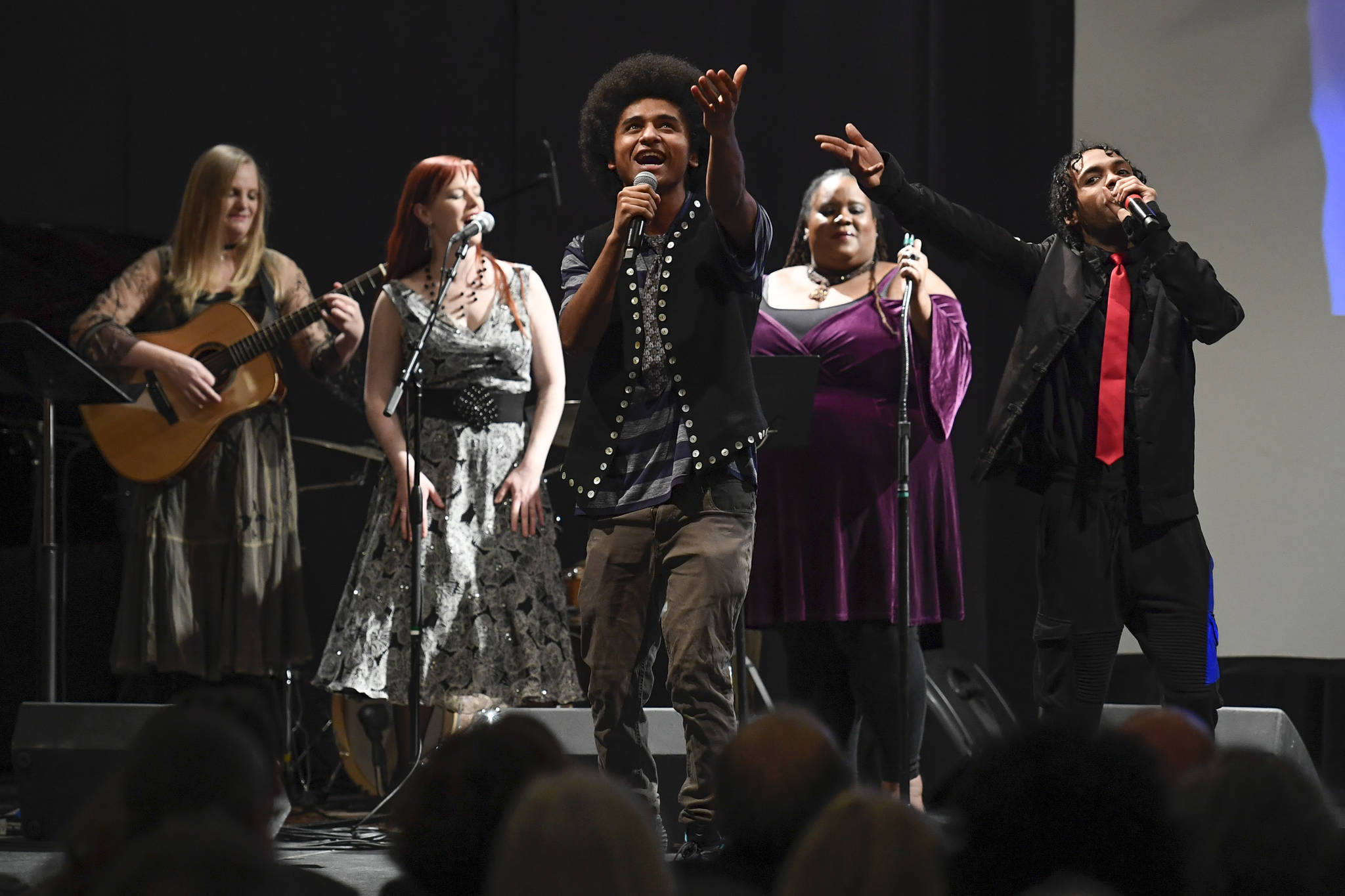Arias Hoyle has rapped along to live instruments before and played for some big shows, but Thursday night was the first time the rapper known as Air Jazz has been aired on live television.
Hoyle, a 17-year-old junior at Juneau Douglas High School: Yadaa.at Kalé, was part of a group of Juneau artists who performed during the Governor’s Arts and Humanities Awards, which was televised on 360 North. He was excited for it.
“You better believe it,” Hoyle said in a Thursday afternoon interview ahead of the event. “This is my first live TV event. We’ve traveled to Seattle and even that wasn’t a live event.”
[PHOTOS: Governor’s Arts and Humanities Awards]
He was joined on stage by his beatboxing, hook-singing partner in rhyme Chris Talley, who performs as Radiophonic Oddity, as well as local songwriters and musicians Laura Zahasky, Luke Weld, Clay Good, Jocelyn Miles and Marian Call, who masterminded the Juneau super group and performed throughout the evening.
“They’re from different musical worlds, but they’re all at the top of their game,” Call said before the show.
The collaborative arrangement written by Jacob Brouillette, Marcel Cohen, Bradley Dybdahl, Hoyle, Keegan Kanan, Geri Rodriguez and Kenndra Willard included a few bars of Hoyle’s song “”Ixsixán, Ax Kwáan (I Love You My People).
While Hoyle and Talley performed at the forefront of the stage, the other talents danced and clapped along. When Miles’ or Call were at the helm, Hoyle and Talley reciprocated moving along to the music.
The group performance was the last song played during the evening and drew some of the night’s loudest applause.
[Arts and Humanities Awardees include familiar Southeast faces]
As is the case with many of Hoyle’s raps, the performance included lyrics in Lingít, the Tlingit language.
“It pretty much started in middle school, I was just starting to learn to speak Lingít,” Hoyle said. “Ever since I learned some of their words, I’ve tried to piece together words that rhyme in Lingít. It makes things even better that for a while Lingít was a completely dying language. I had to think, ‘How can I make this flourish when I’m just a lyricist, rapper and performer?’”
Since the get-go Hoyle, who is half African-American, about a quarter Tlingit and a quarter Native American — mostly Blackfoot and Cherokee — has been striving to make a cultural blend that’s true to him.
“It was a way to show all my culture in one,” Hoyle said.
Despite his young age, that’s something Hoyle’s been at for a while.
He started writing raps around age 10, started learning Lingít in middle school and began making beats using Garage Band in eighth grade.
The music video for his song “Spirit,” created in collaboration with Central Council of Tlingit & Haida Indian Tribes of Alaska, is anticipated to debut in March and it will represent a new apex in the effort.
The lyrics for that newest effort, “Spirit” are almost entirely Lingít, Hoyle said.
Tlingit & Haida President Chalyee Éesh Richard Peterson Peterson praised Hoyle’s vision and tenacity and said those qualities are why Hoyle will be receiving an Emerging Leader Award at an April awards banquet.
“He seems to be quite fearless,” Peterson said. “He’s really moving things forward integrating culture in an artistic way.”
And you don’t stop
Hoyle has a growing to do list and no plans to give up on music with college on the horizon.
In addition to the upcoming music video, Hoyle said he recently applied to have an EP of Talley and his music available on iTunes, and there’s tentative hopes to release some physical media.
“It won’t be soon, I’ll admit that, but we do plan to eventually put them on hard CDs. If we do get far with it, vinyl would be nice.”
He’s also applied to and hopes to attend Cornish College of the Arts in Seattle, which would be near some of Hoyle’s Lower 48 family — the other half resides in Pekin, Illinois — and offer some an opportunity to continue what he loves to do.
[She went from Juneau to Portland to fashion’s biggest stage]
“At first I was inspired because it’s an arts performance school, so you’d get a production degree, and you’d be a performer as well,” Hoyle said.
A recent meeting with the indigenous funk-rock band Khu.éex’ with whom Hoyle performed during their January Juneau performance further instilled the desire to attend Cornish.
“They said most of their drum friends, most of their singer friends, they enrolled in Cornish,” Hoyle said.
Switching up the style
When rapping in English, Hoyle has a buttery, understated flow that wouldn’t sound out of place on a classic De La Soul album or as a feature on an early Common cut.
Some of his rap heroes include Tupac, Nas, Rakim and early Eminem.
“The guys who are really lyrically mastered and driven and have a lot of personality in their music,” Hoyle said.
[See some seriously impressive dolls]
From a production standpoint, Clams Casino, who is known for his work with A$AP Rocky, is one of his favorites.
Those touchstones come across in the music he makes as Air Jazz or as Radiophonic Jazz when working with Talley.
When rapping in Lingít, Hoyle’s style changes.
“On one hand, I have my African-American side, and I do kind of the normal boom bap serene type of music, and when it comes to the Tlingit side, it mashes two different sounds together,” Hoyle said. “It makes for really powerful ancestral cadence when doing it in Lingít.”
Hoyle said discussing his style, musical influences and ambitions wouldn’t be complete without listing one more figure — his songwriter father Mike Hoyle.
“As far as just life inspirations, I look up to my dad,” Hoyle said. “He’s a songwriter himself, but he is not a performer.”
• Contact arts and culture reporter Ben Hohenstatt at (907)523-2243 or bhohenstatt@juneauempire.com. Follow him on Twitter at @BenHohenstatt.

